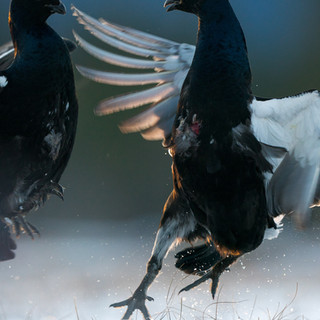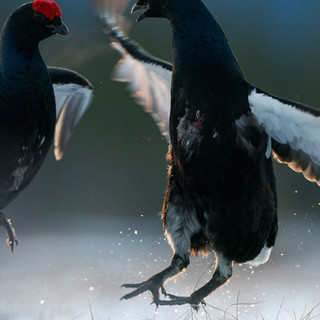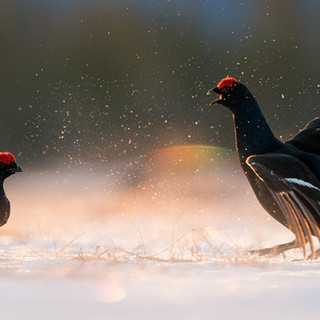PHOTOGRAPHING FIGHTING BLACK GROUSE WITH THE SONY A9 AND SONY 400MM F2.8 GM OSS
- florissmeetsphotog
- May 10, 2019
- 7 min read

For the past 5 weeks I have been working with black grouse and capercaillie photography. Most of the work consist out of getting my clients to photograph these species from my hides. Now and then I get the chance to join my guests on the leks and get some shots myself. For quite some time I have been looking forward to photograph the black grouse with the Sony a9 and Sony 400mm f2.8 GM OSS lens. The autofocus of the a9 and 400mm have proven to be extremely fast, accurate and has never left me down. Birds in flight with obstructing subjects, distracting backgrounds or back light have never caused any problems for the autofocus system of the a9. But anyone who has tried to photograph the extreme fast fights of the black grouse, knows that this is a whole different game.
The fights normally last only a second or less. For the naked eye they seem rather harmless and not that spectacular. But with the high frame rate of a camera you can capture what actually takes place within that short moment. The birds manage to pull feathers out of each other, kick and hit each other and this often suspended in mid air. Until now the Canon 1DX (with 12 frames per second) was the fastest camera I have used for photographing this. The Sony a9 does 20 frames per second, meaning I am be able to get another 8 frames per second of fighting.
The extreme fast and unpredictable movements of the black grouse during the fights, make it a challenge for any camera to keep the focus on the head of the bird. The birds jump so fast left, right, forward and backward, that the autofocus often jumps from the head to the body or wings of the bird or to the background. Another problem is that the birds often jump out of the autofocus field of the camera. This problem should be solved by the Sony a9, since 93% of the sensor is covered with autofocus points. Then there still is the up flying snow, water and vegetation which pose another difficulty for the autofocus system. All these factors result most often in only a couple of sharp images in a burst of shots and you end up throwing away the majority of the images.
The higher frame rate, more autofocus points, faster autofocus system (60 autofocus measurements per second), no black out between the images and better tracking capabilities of the a9, in combination with the extremely fast 400mm f2.8 GM OSS, should result in more sharp pictures than what I have been able to get until now. There was only one small problem. ...I had an accident and drowned my Sony a9 in the ocean before the grouse season started.
I still had the Sony a7RIII, but this is not a sports camera. It has a lower frame rate and the auto focus system is not as snappy as the one of the a9. The terrific images quality, insane dynamic range and resolution for sure make up for that. Yet, it was not the combination I wanted to use for the black grouse fights. After a long wait, my new Sony a9 arrived a few days ago. The weather forecast predicted a clear morning the following day. After that the weather would change for the worst, so I had only one morning with the grouse. ...and what a morning it was!
Sony a9, Sony 400mm f2.8 GM OSS @ 400mm, f2.8, ISO 1600, 1/640s
I mainly focused on photographing the fights, even though the conditions were not the best for that. The lekking season has almost come to an end, which means that the activity of the birds has dropped. They don't fight as much anymore and the fights are short. Also the birds had chosen that morning to mainly play close to my hide. Which is perfect for portraits, but far from ideal for photographing fights.

Not an ideal distance for fighting shots!
Sony a9, Sony 400mm f2.8 GM OSS @ 400mm, f2.8, ISO 1600, 1/640s
These are the factors I had to deal with:
It was almost impossible to fit two birds into the frame, let stand trying to keep two birds in the frame while they jump from left, right, up and down.
The relative movement of the birds to the sensor increases when the distance decreases. Which doesn't only make it more difficult for the autofocus to track the subject correctly, but also for me to keep the autofocus point on the head of a bird if I would choose single or groups of focus points.
The depth of field decreases when the distance to the subject decreases. Meaning that I have to increase the aperture in order to maintain enough depth of field, which results in a lower shutter speed.
Pieces of vegetation were sticking out of the snow. The two black grouse which had most of the fights, were fighting exactly behind a patch of tall grass.
I had chosen to work with back-light, which makes it even more difficult for the autofocus system to track the subjects correctly.
Snow and water flew up during the fights. This in combination with back-light, makes it extra difficult for the autofocus to track the subject.
Sony a9, Sony 400mm f4 GM OSS @ 400mm, f2.8, ISO 1600, 1/1000s
Even though the odds were against me, the Sony a9 in combination with the Sony 400mm f2.8 absolutely blew me away! I never would have thought that any camera would be able to track a subject, which is moving so fast in different direction, so well! Sadly, because the birds were so close, in most of the shots some parts of the birds are cut off.
Notice how well the autofocus tracks the head of the bird,
even though it moves all the way up to the outer edges.
Sony a9, Sony 400mm f4 GM OSS @ 400mm, f4, ISO 1000, 1/1250s
I mainly used AF-C, with "Lock-on AF:Flexible Spot". This means that I start with either a single focus point or a group of focus points and afterwards the camera will freely track the subject while it moves through the frame. I'm amazed to see how well the focus stays on the head of the birds, even when they change direction, jump, lower their head, run to the outer corners of the image and during the fights.
Only when I photographed with more harsh back-light, I also tried "Expend Flexible Spot", which is a focus point with the 8 surrounding focus points also activated, or to a single autofocus point. The highest percentage of sharp images per burst I achieved with the "Lock-on AF:Flexible Spot", because the autofocus points tracked the birds through the frame. With the two other methods it is my own job to try to keep the focus point(s) on the head of the bird. Which is a mission impossible when the birds are standing this close.
11 conjunctive images plus one right after the fight.
Sony a9, Sony 400mm f4 GM OSS @ 400mm, f4, ISO 1000, 1/800s
Normally I wouldn't include this many images in a single blog post. But the best way to show you how good of a job the autofocus of the Sony a9 in combination with the Sony 400mm f2.8 did, I decided to just show you how many sharp images I got from a single photo session. These are not all the fighting pictures I took that morning, but these are the longer burst I took. Picking out single sharp images wouldn't be convincing enough. Those could just be lucky shots. Here you can see the consistency of the the focus during the fights.
Sony a9, Sony 400mm f4 GM OSS @ 400mm, f4, ISO 800, 1/2000s
Even with strong back-light the focus keeps tracking the head of the bird.
Sony a9, Sony 400mm f4 GM OSS @ 400mm, f4, ISO 800, 1/4000s
As you can see, there are whole series of pictures where the autofocus nailed every single image. There might be an image or two where the sharpness seems a bit soft, but with the next shot it is razor sharp again. There are also some images where there is some motion blur, because the shutter speed wasn't high enough. This has nothing to do with the autofocus. As you can see, the focus never really lost the subject and did an extraordinary job in keeping the focus on the head of the birds. This is the 10th spring that I'm photographing the black grouse and I never had such a high number and percentage of sharp fighting pictures! And this while the odds were against me.
To show you how fast the birds move, here two bursts of together 23 images. Halfway the fight I thought that it was over, but then the shortly snapped once more at each other. Therefor there is about half a second missing, but these are conjunctive files. I didn't crop these files to show you how fast they can move out of the frame.
Sony a9, Sony 400mm f4 GM OSS @ 400mm, f4, ISO 640, 1/2000s
Also up flying snow with back light didn't throw off the autofocus. Find below another single burst. This time consisting out of 12 images. With 20 frames per second, this means that this whole event only lasted just over half a second!
Sony a9, Sony 400mm f4 GM OSS @ 400mm, f4, ISO 640, 1/3200s
This was the last fight of the morning and also this one the focus nailed it!
Sony a9, Sony 400mm f4 GM OSS @ 400mm, f4, ISO 400, 1/5000s
My conclusion. ...well, do I really need to say it??? I think the images speak for themselves. The combination of the Sony a9 and the Sony 400mm f2.8 GM OSS had already proven themselves to me earlier. Yet, this set up managed to completely blow me away once more. The speed and accuracy of the autofocus system is just phenomenal and manages to lock on to the subject even in these challenging conditions. I can only imagine what kind of shots I would have been able to get if the birds had played 3-5 meters further away from my hide. Sadly I have to wait now another year until I can get another session with these birds. ...can't wait!
Disclaimer.
I didn't have the time to update the firmware on the Sony a9 before this photo session. I photographed this session with firmware 4.10 and not with the new 5.0. The new firmware is supposed to do an even better job with tracking a subject.
Because I wanted to show this large amount of images, I didn't have the time to properly edit them. I haven't done any noise reduction, local sharpening or any other local adjustments. For each burst of images, I applied the same adjustments in Lightroom in order to process them as fast as possible.


















































































































































































Comments